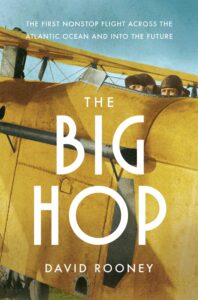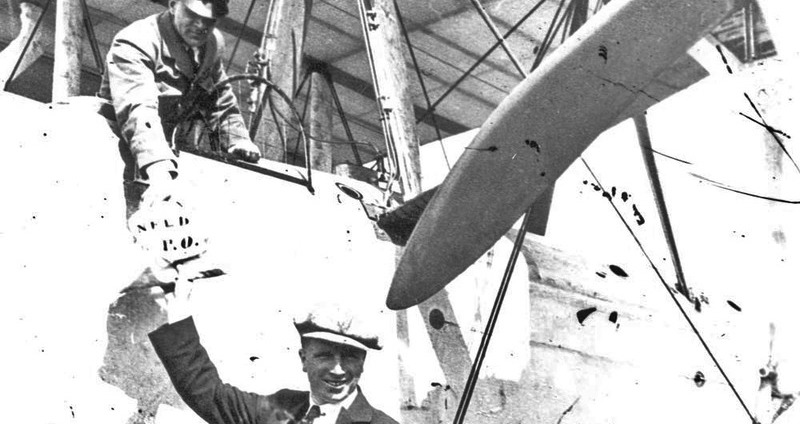In the early afternoon of June 14th, 1919, two young men struggled into heavy flying suits, then climbed into a modified Vickers Vimy biplane on Lester’s Field, a mile from downtown St. John’s, Newfoundland. The airplane was an unwieldy, twin-engine ex-bomber, retrofitted with fuel tanks where formerly the bombs would have been held. Its fuselage and wings were made of stiff Irish linen over a framework of wood spars and steel tubing, and its navigational instruments, by modern standards, were rudimentary: two compasses, an air-speed indicator, and an aneroid barometer. The two-seat cockpit was open to the sky. On board were charts, some food, a bag of mail—and two stuffed black-cat mascots named “Lucky Jim” and “Twinkletoe.”
Article continues after advertisement
Then there were the airmen themselves. John “Jack” Alcock, from Manchester, was one of Britain’s finest wartime pilots. His navigator, Arthur Whitten “Ted” Brown, was British by birth, American by citizenship. Their destination that day was the British Isles. Their ambition: to be the first to fly non-stop across the Atlantic.
Alcock and Brown needed each other: the airman and the engineer, pilot and navigator, but it didn’t make for a lasting story.
A little over sixteen hours later, they landed on soft bogland near Clifden, on Ireland’s remote Galway coast. Within minutes of their arrival, a party of officers, soldiers, and operators based at Clifden’s big wireless station came laboring across the muddy ground.
An officer shouted out, “Anybody hurt?”
“No,” the airmen answered.
“Where you from?”
“America.”
The airplane was damaged in the landing, tipping forward into the bog, but Alcock and Brown had succeeded: they’d completed what some—especially in America—called “the big hop.” They were feted all along their journey from Clifden to London. Crowds lined the route and flocked to the streets of the capital. There were parties and banquets, and the King knighted the two men. The world took note. And then, it moved on.
More than a century later, the names Alcock and Brown stir little recognition, especially in America. Their story has dimmed to a historical footnote. The stone monuments to the men’s success stand windswept and largely unnoticed on the Galway coastline. In the popular memory of aviation, Charles Lindbergh stands as the pioneer of transatlantic flight. His 1927 solo journey from New York to Paris captured the imagination of a roaring decade. Amelia Earhart, five years later, cemented her own name in history by becoming the first woman to do the same. The two celebrities became synonymous with daring and adventure. Alcock and Brown vanished from the spotlight almost as quickly as they entered it.
It wasn’t for lack of drama. Their sixteen-hour flight was anything but routine. Flying blind through thick fog and storms, they contended with freezing temperatures, mechanical failures, and icing so severe that the ailerons seized. They relied on dead reckoning most of the way, with only scant celestial sightings. Their only communication was a shout or a pencil-written note. They had no modern navigation, no autopilot, no parachutes, and their wireless failed within moments of starting the journey. It was raw, instinctive flying.
Timing played its part in how we remember the story. The achievement of Alcock and Brown came just months after the end of the First World War, at a moment when too many families were grieving the loss of an airman brother, father, or son. Alcock and Brown had themselves only recently awoken from nightmares of captivity in Turkey and Germany after airplane crashes. The air, for many, still carried the taste of blood and smoke; the Vimy, a product of war, was only a reminder of the conflict. There was little appetite for new aerial legends. The two airmen were modest and did not seek glory, and they did not linger long in the public eye.
Lindbergh’s flight was a different matter. His solo hop, eight years after Alcock and Brown’s team effort, took place in a different age. The 1920s was a crazy decade. America was flushed with postwar optimism and a dynamic cultural energy. Lindbergh, the tall, fresh-faced Midwesterner, embodied a new American archetype: the Lone Eagle. Alone in his spunky little Spirit of St. Louis, he bridged the old world and the new with machine-age, movie-star resolve. The narrative was irresistible. The ticker tape parades, the breathless media coverage, the mythologizing—it all followed naturally.
Amelia Earhart followed her own plotline. When she made her solo transatlantic crossing in 1932, she did so not only as an aviator, but as a symbol of social change. She flew against the pull of convention. “I chose to fly the Atlantic because I wanted to,” she wrote, a few days after the flight. “It was, in a measure, a self-justification—a proving to me, and to anyone else interested, that a woman with adequate experience could do it.” Her public persona—unconventional and relentlessly modern—was a perfect symbolic fit for her time.
Alcock and Brown, by contrast, never really became symbols. Their flight lacked a singular protagonist. It was a partnership, and it was muddy, cold, and technical. Their machine was no icon of modernity with a sleek silhouette; it was heavy and ungainly—a slab-sided hulk of steel, canvas, and wire. And there were few carefully staged photographs of winning grins taken at the Clifden bog as the Vimy sat with its nose crumpled into the earth. Alcock and Brown were veterans of a recent and brutal war, and they flew as engineers, not avatars.
Perhaps the greatest erasure is that of Ted Brown’s identity, which has all but disappeared from American memory—despite him being an American citizen. He was born in Scotland, but his mother was a Pittsburgh native, his father from Schenectady. Ted spent his youth moving between the U.S. and the U.K. He worked for the Westinghouse engineering company in Pittsburgh as well as its British offshoot in Manchester. It was as if he lived on the Atlantic: straddling it, with one foot in North America and the other in Britain.
The American press at the time registered this detail, but did not dwell on it. The 1919 flight was framed as a British triumph. There were no parades in Pittsburgh, no civic celebrations in Schenectady. When Lindbergh flew eight years later, it was as if no one had preceded him. Jack Alcock died in an air crash over France in December 1919. Brown, always reserved, did little to claim the narrative. A post-flight lecture tour of America flopped, and he turned to the life of a mid-rank businessman, settling in Swansea, Wales. He turned in on himself. When he was asked, soon after the flight, about his experience in the air over the Atlantic, he said, “I wouldn’t do it again for anything on earth.” History, hungry for a hero, found him unaccommodating.
A non-stop flight across the Atlantic might be routine to us. It almost feels like a chore. But it’s only possible because Jack Alcock and Ted Brown went first.
In America, the twentieth century felt like a parade of individuals. History celebrated the soloist, the rebel, the star—the Lone Eagle. Partnerships made things more complicated. Even Wilbur and Orville Wright became merged into a single identity: the Wright Brothers. Alcock and Brown needed each other: the airman and the engineer, pilot and navigator, but it didn’t make for a lasting story. It was a tandem effort, and didn’t catch on into myth.
The 1919 crossing proved that the Atlantic could be bridged by air. It made Lindbergh’s flight conceivable, not unimaginable. Lindbergh himself acknowledged the debt. Upon landing in Paris, he is said to have asked the crowd, “Why all this fuss? Alcock and Brown showed us the way.” Amelia Earhart, reflecting on the 1919 flight, called it “an amazing feat, and the least appreciated.”
The sky over the Atlantic is crowded now with contrails. The crossing is routine, tracked by satellite and guided by autopilot. In 1919, it was something else. It was a hop into the unknown, made by two men in heavy flying suits carrying black-cat mascots in an open cockpit: modest individuals, bruised by war, who had been up for a challenge, and then moved on.
The airmen of 1919 are now long gone. But there is one character from that episode still here and in good health. The Vimy that Alcock and Brown flew was presented to the London Science Museum a few months after the crossing. It’s been on display ever since—and I used to look after it. I was the museum’s curator of transport during the 2010s, and some of the world’s most important aviation relics were my care and responsibility. Including the Vimy.
It always called out to me. I wanted to put Jack and Ted back into the spotlight. Writing their story in The Big Hop: The First Non-Stop Flight Across the Atlantic Ocean and into the Future (W. W. Norton, June 3rd, 2025) was my way of paying tribute to them, and to all the other aviation pioneers—men and women, of all ages, from all walks of life—who risked everything: for freedom, for progress, and for us.
A non-stop flight across the Atlantic might be routine to us. It almost feels like a chore. But it’s only possible because Jack Alcock and Ted Brown went first.
__________________________________

The Big Hop: The First Non-Stop Flight Across the Atlantic Ocean and into the Future by David Rooney is available from W.W. Norton & Company.
